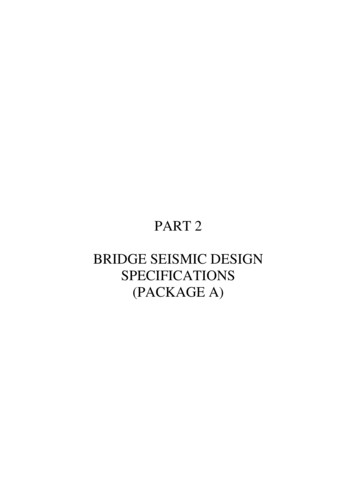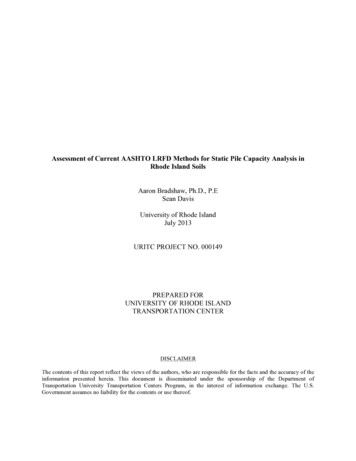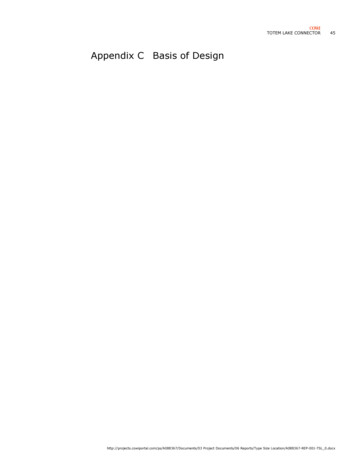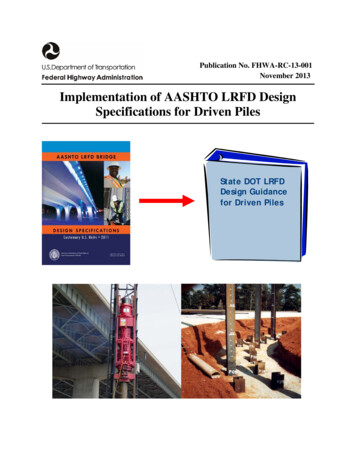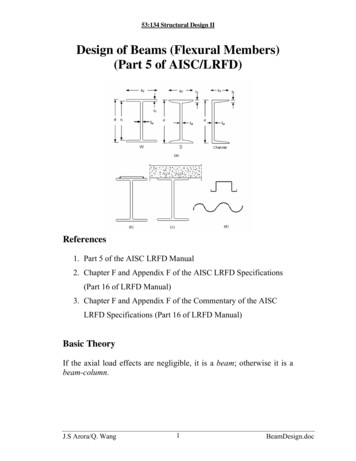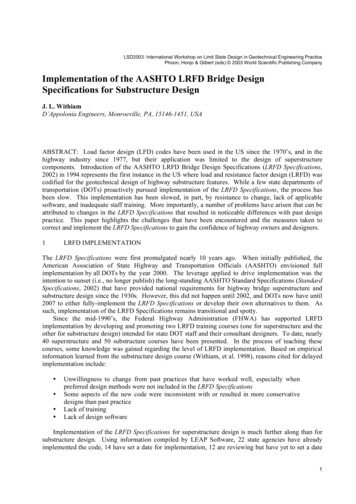
Transcription
LSD2003: International Workshop on Limit State Design in Geotechnical Engineering PracticePhoon, Honjo & Gilbert (eds) 2003 World Scientific Publishing CompanyImplementation of the AASHTO LRFD Bridge DesignSpecifications for Substructure DesignJ. L. WithiamD’Appolonia Engineers, Monroeville, PA, 15146-1451, USAABSTRACT: Load factor design (LFD) codes have been used in the US since the 1970’s, and in thehighway industry since 1977, but their application was limited to the design of superstructurecomponents. Introduction of the AASHTO LRFD Bridge Design Specifications (LRFD Specifications,2002) in 1994 represents the first instance in the US where load and resistance factor design (LRFD) wascodified for the geotechnical design of highway substructure features. While a few state departments oftransportation (DOTs) proactively pursued implementation of the LRFD Specifications, the process hasbeen slow. This implementation has been slowed, in part, by resistance to change, lack of applicablesoftware, and inadequate staff training. More importantly, a number of problems have arisen that can beattributed to changes in the LRFD Specifications that resulted in noticeable differences with past designpractice. This paper highlights the challenges that have been encountered and the measures taken tocorrect and implement the LRFD Specifications to gain the confidence of highway owners and designers.1LRFD IMPLEMENTATIONThe LRFD Specifications were first promulgated nearly 10 years ago. When initially published, theAmerican Association of State Highway and Transportation Officials (AASHTO) envisioned fullimplementation by all DOTs by the year 2000. The leverage applied to drive implementation was theintention to sunset (i.e., no longer publish) the long-standing AASHTO Standard Specifications (StandardSpecifications, 2002) that have provided national requirements for highway bridge superstructure andsubstructure design since the 1930s. However, this did not happen until 2002, and DOTs now have until2007 to either fully-implement the LRFD Specifications or develop their own alternatives to them. Assuch, implementation of the LRFD Specifications remains transitional and spotty.Since the mid-1990’s, the Federal Highway Administration (FHWA) has supported LRFDimplementation by developing and promoting two LRFD training courses (one for superstructure and theother for substructure design) intended for state DOT staff and their consultant designers. To date, nearly40 superstructure and 50 substructure courses have been presented. In the process of teaching thesecourses, some knowledge was gained regarding the level of LRFD implementation. Based on empiricalinformation learned from the substructure design course (Withiam, et al. 1998), reasons cited for delayedimplementation include:yyyyUnwillingness to change from past practices that have worked well, especially whenpreferred design methods were not included in the LRFD SpecificationsSome aspects of the new code were inconsistent with or resulted in more conservativedesigns than past practiceLack of trainingLack of design softwareImplementation of the LRFD Specifications for superstructure design is much further along than forsubstructure design. Using information compiled by LEAP Software, 22 state agencies have alreadyimplemented the code, 14 have set a date for implementation, 12 are reviewing but have yet to set a date1
for implementation, and two have no plans as yet for implementation. Figure 1 illustrates the level ofimplementation for each state agency.Because the NHI substructure course was presented between 1998 and 2002, the empiricalinformation obtained from the course regarding LRFD implementation substructure design is somewhatdated. Therefore, a survey was taken recently of state DOTs to obtain a snap shot of the current level ofLRFD implementation for substructure design. The survey form was sent by email to each state agency,and is reproduced here in Table 1. The information requested in the survey was limited to minimize thetime needed to complete the form to less than five minutes and hopefully generate a reasonable number ofresponses.Survey responses were received from 22 states within the two week time limit requested when thesurvey was mailed. Of the agencies responding, 10 were from agencies that have already implementedLRFD for design superstructures, or about 45 percent of the agencies nationally. Of these, five agenciesstated that they design substructures using the LRFD Specifications with exception, and the remainingfive continue to design substructures using the Standard Specifications. Some of the exceptions notedinclude: Design deep foundations using provisions developed by agencyDesign foundations using LRFD Specifications but design walls using StandardSpecificationsDesign all substructures using LRFD Specifications but design MSE walls usingStandard SpecificationsThe results of this recent survey are consistent with empirical information gathered during thesubstructure design course. Reasons for these trends include 1) differences between LRFD designpractice with past practices, 2) problems associated with calibrating the LRFD Specifications, especiallyfor deep foundations and some wall types; and 3) perceived problems due to a lack of understanding.These issues are addressed in the following sections.2CHANGES IN DESIGN PRACTICEAs an entirely new specification, development of the LRFD Specifications provided an opportunity tomake changes in design methodology to reflect changes in observed structure behavior relative to pastdesign practice. Perhaps the most noteworthy change was the development of an entirely new model forvehicular traffic, reflecting changes in current and anticipated traffic loading. However, some lessobvious changes were made in the substructure design provisions that had a significant effect when theLRFD Specifications were first published. These include 1) the location of the resultant earth pressureused for retaining wall design, 2) the live load surcharge applied on the retained soil mass behind walls tosimulate the effects of vehicular traffic behind the wall, and 3) application of the new vehicle live loadmodel and load distribution through the soil cover above culverts. The rationale for these changes andtheir impact on the LRFD Specifications will be described.2.1Location of Resultant Lateral Earth PressureThe magnitude of lateral earth pressure loads on a on a retaining wall or abutment is a function of: Structure typeType, unit weight, and shear strength of the retained earthAnticipated or permissible magnitude and direction of lateral substructure movementCompaction effort used during placement of soil backfillLocation of the ground water table within the retained soilLocation, magnitude, and distribution of surcharge loads on the retained earth massThe stiffness of the structure and the characteristics of the retained earth are the most significantfactors in the development of lateral earth pressure distributions. Walls that can tilt, move laterally, orImplementation of the AASHTO LRFD Bridge Design Specifications (J. L. Withiam)2
Implemented AlreadyReviewing. No Implementation Date SetImplementation Date SetNo Plans to ImplementFigure 1. LRFD Implementation for Superstructure Design(Modified after Leap Software, Inc., 2003)
Table 1.Survey FormI was responsible for developing training materials and was an instructor for the NHI course “LRFD for Highway BridgeSubstructures.” Before each course we surveyed the host agency to learn about their implementation of the AASHTO LRFDSpecifications for Highway Bridges (LRFD Specifications). While the course was presented nearly 50 times to more than 30 agencies,nearly 5 years has passed since the first course was presented. Because much has changed we began, I ask you to take about 5minutes to respond to the few questions below. I will use this information for part of a paper and presentation I will make in Bostonnext month at a workshop on limit states design in geotechnics. I will send a copy of the paper, “Implementation of the AASHTOLRFD Bridge Design Specifications for Substructure Design.” Thank you.1. What state agency do you represent?2. Your name:3. Your email address:If your agency HAS NOT yet implemented the AASHTO LRFD Specifications, please complete Question 4 and return the survey. Ifyour agency has implemented the LRFD Specifications, please answer Questions No. 3 - 7 and return the survey.4. If your agency HAS NOT implemented the LRFD Specifications, what year do you plan to start?5. If your agency HAS implemented the LRFD Specifications, what year did you start?6. Does your agency use the LRFD Specifications for substructure design? W/O exceptions; W/ exceptions; Highlight your responsein bold.7. If your agency takes exception to the LRFD Specifications for substructure design, highlight in bold those provisions you DO NOTuse? Spread footingDriven pileDrilled shaft Conventional wallPrefabricated modular wallFlexible cantilever wallImplementation of the AASHTO LRFD Bridge Design Specifications (J. L. Withiam) Anchored wallMSE wallFlexible culvertRigid culvert4
deflect structurally away from the retained soil (i.e., most retaining walls and abutments) can mobilize anactive state of stress in the retained soil mass. These structures are typically designed using an active (i.e.,minimum) lateral earth pressure distribution. Walls restrained against movement (e.g., integral abutmentsor walls for which lateral movement of the backfill could adversely affect nearby facilities) are typicallydesigned to resist an at-rest earth pressure distribution. Walls forced to deflect laterally toward theretained soil are designed to resist the passive earth pressure. For practical purposes, the passive state ofstress occurs most commonly as a result of lateral deflection of the embedded portions of retaining wallsin the supporting soil. In the LRFD Specifications, passive earth pressure is treated as a resistance ratherthan a load.The basic earth pressure, p, can be estimated using:p K h γ ′s zwhere:p Lateral earth pressureKh Lateral earth pressure coefficientγ ′s Unit weight of soilz Depth from ground surfaceThe value of Kh used for design depends on the stress history of the soil (i.e., whether the soil isnormally-consolidated [NC] or overconsolidated [OC]) and the displacement of the structure (i.e.,whether the structure is flexible or stiff and whether soil loading is active or passive). The initial or atrest value of Kh (i.e., Ko) ranges between about 0.4 and 0.6 for NC soils, and can exceed 1.0 for heavilyOC soils. Structure movement will increase or decrease the value of Kh from Ko such that movementaway from the soil will cause the value of Kh to decrease below Ko and movement toward the soil willcause the value of Kh to increase above Ko. Minimum and maximum values of Kh (i.e., Ka, and Kp) aremobilized when the shear strength of the soil is completely mobilized. For conventional walls (i.e.,gravity, semi-gravity and inverted T-type cantilever), the lateral movement required to develop theminimum active earth pressure or maximum passive earth pressure is a function of the type of soilretained, as shown in Table 2.Table 2. Relative Movements Needed to Achieve Active or Passive Earth Pressure Conditions(Clough and O'Rourke, 1991)Values of /HBackfill TypeActivePassiveDense Sand0.0010.01Medium Dense Sand0.0020.02Loose Sand0.0040.04 Lateral movement needed to mobilize active or passive earth pressureH Wall heightNearly all cantilever retaining walls of typical proportions used for highway applications deflectsufficiently to permit mobilization of active earth pressures. Gravity and semi-gravity walls designedwith a sufficient mass to support only active earth pressures will tilt and/or translate in response to moresevere loading conditions (e.g., at-rest earth pressures) until stresses in the retained soil are relievedsufficiently to permit development of an active stress state in the retained soil. However, at-rest earthpressures could develop on the stem of cantilevered retaining walls where a rigid stem-to-base connectionmay prevent lateral deflection of the stem with respect to the base. For such a condition, excessive lateralearth pressures on the stem could conceivably cause structural failure of the stem or stem-to-baseconnection.Implementation of the AASHTO LRFD Bridge Design Specifications (J. L. Withiam)5
As shown in Figure 2a, the resultant force from a linearly increasing pressure distribution is located atthe centroid of the pressure diagram at H/3 from the base of a wall which tilts about its base. However, ifthe wall tilts about its top or translates laterally as shown in Figures 2b and 2c, the location of theresultant force is higher than traditionally assumed for design. Location of the resultant force above thecentroid of the pressure diagram occurs because as a wall deflects in response to lateral earth loading, thebackfill must slide down along the back of the wall for the retained soil mass to achieve an active state ofstress. This movement causes arching of the backfill against the upper portion of the wall which causesan upward shift in the location at which the resultant of the lateral earth load is transferred to the wall.Recognizing the possibility of these different responses to lateral earth loads, the LRFD Specificationsprescribed that the resultant earth lateral pressure be located at 0.4H from the base of the unsupportedwall section for conventional gravity and inverted T-type cantilever walls. For other wall types (i.e.,nongravity cantilever or other types of flexible walls which tilt or deform laterally in response to lateralloading), significant arching of the backfill against the wall does not occur, so that the resultant lateralload due to active and other pressure distributions could be assumed to act at H/3 above the base of thewall.(a) Tilting About Base(b) Tilting About Top(c) TranslationFigure 2. Location of Resultant Lateral Earth Pressure (Hunt, 1986)The requirement that the resultant lateral earth pressure be located at 0.4H above the base of gravityand inverted T-type cantilever walls, (rather than H/3 as traditionally done), was controversial and leddesigners to question the validity of the LRFD Specifications. Designers soon realized that locating theresultant earth pressure at 0.4H resulted in an increase in the moment about the toe of 0.4H/0.33H orslightly more than 20 percent in lateral load effect compared to past design practice.In response to numerous comments from DOTs and designers, AASHTO sponsored NCHRP 20-7,Task 88 (Withiam, et al., 1999) to reassess and update the provisions for wall design in the LRFDSpecifications, and to conduct calibration analyses to incorporate performance data compiled since thecode was originally calibrated. As part of that effort, the appropriateness of prescribing 0.4H as thelocation of the resultant lateral earth pressure was reevaluated. This study determined that while theresultant lateral load due to the earth pressure may act as high as 0.4H above the wall base for aconventional gravity retaining wall, such structures walls are not representative of the more flexibleinverted T-type cantilever walls used in highway applications.The flexibility of inverted T-type cantilever walls and the appropriateness of assuming Ka for thedesign were demonstrated in analyses reported in notes for NHI Course No. 13064 (1994). The results ofa series of elastic structural analyses were presented for walls of typical proportions of stem thickness towall height bearing on and supporting dense sand with a horizontal backslope. The walls analyzed variedin height from 1.5 to 9 m. The analyses also considered the effects of creep and cracking of the concretestem. The results of these analyses were then compared with guidelines provided in the LRFDSpecifications, where the lateral deflection required at the top of the wall stem to mobilize Ka for densegranular soil backfill is 0.001H. The results of the analyses are presented in Tables 3 and 4.Implementation of the AASHTO LRFD Bridge Design Specifications (J. L. Withiam)6
Table 3. Stem Deflections Using Full Section Modulus(University of Maryland and NBE, Ltd., 1994)DeflectionEstimated Stem Deflection, AverageWall HeightRequired toStemFor KoFor KaHMobilize KaThickness /H /H(m) 00.600.001510.002410.001Assumes φf 37 , c 0, Ka 0.25, and Ko 0.40 for backfill soil; and f’c 27.6 MPa for concreteTable 4. Stem Deflections Using Reduced Section Modulus Considering Cracking and Creep(University of Maryland and NBE, Ltd., 1994)DeflectionEstimated Stem Deflection, AverageWall HeightRequired toStemFor KoFor KaHMobilize KaThickness /H /H(m) 00.600.004860.007790.001Assumes φf 37 , c 0, Ka 0.25, and Ko 0.40 for backfill soil; and f’c 27.6 MPa for concreteTable 3 shows that lateral deflections are sufficient to mobilize Ka for walls greater than about 5.5-mhigh loaded by an active earth pressure distribution and for walls greater than about 4-m high loaded byan at-rest earth pressure distribution. Table 4 shows the effects of cracking and creep of concrete. Thetable shows that due to the reduced stiffness caused by cracking and creep of concrete in the wall stem,lateral deflections are sufficient to mobilize active earth pressures for walls greater than about 2.0-m highloaded by a Ka earth pressure distribution and for walls greater than 1-m high loaded by a Ko earthpressure distribution. Because the walls were analyzed as supported on a rigid base, the results ignore theeffects of the lateral deflection along the base caused by differential pressure along the wall foundationwhich would also contribute to a reduction in the lateral pressure to active loading. So for this type ofwall, designers can assume that the lateral deformations will be sufficient to mobilize active earthpressures.The results of the evaluations and analyses described here resulted in a recommendation (Withiam, etal., 1999) to permit application of the resultant load from lateral earth pressure at H/3 for conventionalretaining walls. AASHTO incorporated this recommendation in the 2002 Interims to the LRFDSpecifications. However, additional commentary needs to be developed to clarify the application ofcompaction-induced lateral earth pressures and application of a load factor for this force effect.2.2Live Load SurchargeWhen applicable, the force effects of surcharge and traffic loads on backfills must be considered for thedesign of walls and abutments. In the LRFD Specifications, if traffic is expected within one-half theheight behind a wall, the live load traffic surcharge is assumed to act on the retained earth surface. Tosimplify consideration of traffic loads for wall design, AASHTO treats traffic loads as a uniform earthsurcharge on the retained soil. The increase in lateral earth pressure due to live load surcharge isestimated as:Implementation of the AASHTO LRFD Bridge Design Specifications (J. L. Withiam)7
p K s γ ′s h eqwhere: p Constant lateral earth pressure due to uniform traffic surchargeγ ′s Effective unit weight of soilKs Coefficient of earth pressureheq Equivalent height of soil for the design live loadFor active earth pressure conditions, Ks is taken as Ka, and for at-rest conditions, Ks is taken as Ko.The Standard Specifications prescribe that heq 0.61 m. However this provision had remainedunchanged for decades when vehicle loads were much lighter. As a result, development of the LRFDSpecifications provided an opportunity to evaluate the appropriateness of this simplified approach. Forexample, because the weight of vehicle loads had increased over the years, was heq 0.61 still areasonable approximation? For another, because the lateral load effect from surcharges on retaining wallsis greatest near the surface and diminishes nonlinearly with depth, was the simplified approach of auniform lateral load effect regardless of wall height still reasonable? This approach was reevaluated aspart of developing the new code and resulted in a provision in the LRFD Specification that heq be appliedas a function of wall height, as shown in Table 5.Table 5. Equivalent Height of Soil for Vehicular Loading (AASHTO, 1994)Wall Heightheq(m)(m) 1.51.703.01.206.00.76 9.00.61Values of heq in Table 5 were determined based on evaluation of horizontal pressure distributionsproduced on retaining walls from the updated vehicular live load model in the LRFD Specifications usinga Boussinesq elastic half-space solution and a Poisson's Ratio of 0.5.This new model for live load surcharge had a significant effect on the design of most walls. For a 6m high wall, the new model resulted in a 25 percent increase in lateral load from vehicle loadingcompared to past practice, and for shorter walls, the effect was even greater. As a result, the base widthof walls increased. Many wall designers believed the required increase in base width was due to the loadand resistance factors in the new specification. But in fact the greater width was due to an updatedtreatment of live load surcharge using a new live load model to reflect the current weight and size ofvehicle traffic. As a result, designers were suspicious about the new code.In response to concerns from DOTs and designers, more refined analyses (Kim and Barker, 2002)were conducted to study the effect of vehicle loads on retaining structures. These subsequent analysesincluded several differences compared to the original analyses: Wheel loads were treated as uniformly loaded areas rather than point loadsThe loaded surface was analyzed as a two-layer (i.e., pavement and subgrade) rather thana one-layer system (i.e., subgrade only)Application of the AASHTO vehicle load models of truck or tandem plus lane loadSeparate treatment of loading parallel to structure (i.e., retaining wall) and perpendicularto structure (i.e., abutment)Values of Poisson’s Ratio typical of soil backfill rather than ν 0.5Implementation of the AASHTO LRFD Bridge Design Specifications (J. L. Withiam)8
The recommendations resulting from these analyses were introduced in the 1999 Interims to theLRFD Specifications. Table 6 shows that if vehicle wheel loads are applied at the back of a wall less than6-m high, the equivalent load is greater than the value of heq 0.61 used in the Standard Specifications.However, due to the presence of safety barriers near walls used for grade separations, it is unlikely thatwheel loads could be applied at the back of a wall. Therefore, treatment of vehicle loads on retainingwalls in the current LRFD Specifications is the same as in the Standard Specifications.Table 6. Equivalent Height of Soil for Retaining Wall (AASHTO, 2002)Wall Heightheq; from wall(m)0m1m1.51.520.613.01.070.61 6.10.610.61Table 7 shows that the effect of vehicle wheel loads applied at the back of an abutment exceeds thevalue of heq 0.61 used in the Standard Specifications for wall heights of 6 m or less. But because mostDOTs use an approach slab that is partially supported on the abutment, the effects of vehicle loads aregenerally less than used before.Table 7. Equivalent Height of Soil for Abutment (AASHTO, 2002)Abutment Heightheq(m)(m)1.51.223.00.916.10.61So with the changes in the live load surcharge for vehicle loading promulgated with the 1999 Interimsto the LRFD Specifications, the effect of vehicle loading on a retaining structure was then similar, if notidentical, to past practice.2.3Live Load Distribution Through EarthfillThe design of buried structures (culverts) using the LRFD Specifications has resulted in moreconservative designs (i.e., stronger cross section) for culverts with a shallow soil cover ( 3 m) comparedto past practice using the Standard Specifications. The difference in designs using the two design codesis due to a difference in the way the effects of vehicle loading are transferred through thepavement/subgrade to the underlying culvert.For culverts with a shallow soil cover (less than about 3 m), the effects of vehicle loading tend tocontrol the structural design of the culvert cross section. For cover depths greater than 0.6 m, theStandard Specifications prescribe that surface point loads, such as from wheel loads, be spread throughthe soil cover over an area having sides equal to 1.75 times the depth of cover. The LRFD Specificationsassume that for cover depths greater than 0.6 m, the contact pressure from a prescribed tire footprint isdistributed through the soil backfill in a manner similar to the 60 degree (from horizontal) spreading rulefound in many geotechnical textbooks. For depths less than 0.6 m, the area of the tire footprint itself is tobe used to determine pressure below the surface due to live loads. At 1-m depth of cover, thismodification has the effect of increasing design pressures for vehicle loading by 70% compared to themethod used in the Standard Specifications.As with other approximate methods for determining vertical earth pressures, the AASHTOprocedures for spreading live loads through earth fills are intended to obtain force effects averaged acrossthe culvert diameter. These procedures are used to calculate the average wall thrust due to vehicle liveloads, but are not appropriate for determining concentrated force effects from live loads, such as bendingstresses or localized deflections, because actual wheel loads do not distribute uniformly through the soil.Rather, wheel loads distribute more as predicted by elastic theory as shown in Figure 3. This figureImplementation of the AASHTO LRFD Bridge Design Specifications (J. L. Withiam)9
shows that live loads produce much higher localized effects for shallow covers than predicted by theapproximate average pressure models used in AASHTO. However, the peak pressures attenuate rapidlywith depth. Thus, consideration of localized bending effects due to live loads is usually a concern onlyfor culverts with shallow covers or those subjected to larger than typical concentrated live loads.Figure 3. Design Truck Pressure Distribution From Elastic TheoryOther vehicle load effects which were modified in the LRFD Specifications include load factors, liveload impact factors (now termed dynamic load allowance factors), multiple presence factors, and thedesign live load model itself. The LRFD Specifications have reduced the live load factor from 2.0 to 1.75,a reduction of 12 percent. However, both the magnitude and the effective depth of live load impacts havebeen increased. At 1 m of cover, the modification to the impact factor increases design pressures by over125 percent. Also, the multiple lane presence factor has been increased by 20 percent for one lanecontributions, although it was left unchanged for two lane contributions.The net effect on design due to all of the factors is illustrated in Figure 4 for live load contributionfrom the design truck for a single lane contribution. As can be seen, the changes significantly increase theconservatism of the specification for live load design. For a 1-m cover, the required design pressure isabout 100 percent greater for the LRFD Specifications than for the Standard Specifications.Implementation of the AASHTO LRFD Bridge Design Specifications (J. L. Withiam)10
Figure 4. Comparison of AASHTO Live Load Pressures Through Earth FillsWhile considerable effort was expended in developing the live load model in the LRFDSpecifications, the appropriateness of these changes for below-ground structures was not evaluated.Further study is needed to refine the new LRFD live load model for the design of culverts.3CALIBRATION ISSUESFHWA’s Jerry DiMaggio has identified the following requirements for a design code:yyyyyMust be completeAll failure modes (limit states) must be addressedGuide a designer through the design processMust be unambiguous so that each competent user gets the same resultDocument development so it can be checked and modified in the futureWhile delayed implementation of the LRFD Specifications can be attributed to failure to meet someof these requirements, the LRFD Specifications, like other limit states codes, have had their growing painsfor other reasons. Some can be attributed to difficulties encountered when the code was first calibratedduring the early 1990’s. For walls and abutments, difficulties were encountered by trying to attemptreliability-based calibrations with limited data. But the most problematic area has been the design of deepfoundations, and in particular driven piles. Because such a large number of methods have been developedfor the geotechnical design of driven pile foundations, calibration of the LRFD Specifications was limitedto a few of the most commonly used methods. As a result, some methods used with success by somestate agencies were not calibrated. Another impediment developed when designers learned that thecalibrated resistance factors presented in the LRFD Specifications did not consider that driven pile designroutinely integrates feedback from the monitoring of test piles during driving and load testing to confirmcapacities estimated during design. In an attempt to correct this problem, a later change to the LRFDSpecifications by AASHTO only exacerbated the situation which led to added confusion and mistrust ofthe code for substructure design. Similar, although far less troublesome concerns have been raised forother portions of the LRFD Specifications in the areas of drilled shaft, anchored, and MSE wall design.3.1FoundationsThe LRFD Specifications include provisions for the design of spread footing, driven pile and drilled shaft
Implementation of the AASHTO LRFD Bridge Design Specifications (J. L. Withiam) 4. Table 1. Survey Form I was responsible for developing training materials and was an instructor for the NHI course "LRFD for Highway Bridge Substructures." Before each course we surveyed the host agency to learn about their implementation of the AASHTO LRFD
